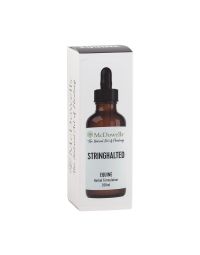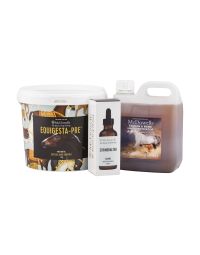Stringhalt in horses is generally classified into two primary types: acquired and idiopathic. Idiopathic stringhalt, also known as classic or true stringhalt, arises without a clearly identifiable cause.
It may be associated with nerve damage resulting from trauma to areas such as the back, neck, or hind limbs. Unlike the acquired form, idiopathic stringhalt does not typically occur in outbreaks and may not resolve on its own, often requiring more intensive management or intervention.
What is Australian Stringhalt?
Australian Stringhalt is a neurological disorder in horses, marked by sudden, exaggerated flexion of the hind limbs during movement. This condition is most prevalent in Australia due to its extreme weather conditions, particularly during droughts.
The Culprit: Hypochaeris radicata
The primary suspect behind Australian Stringhalt is the plant Hypochaeris radicata, commonly known as catsear, flatweed, or false dandelion. Under stress, such as during drought conditions, this plant is believed to produce neurotoxins affecting the horse's nervous system. Horses grazing on overgrazed pastures with abundant catsear are at higher risk of what is called 'Australian Stringhalt'.
Identifying Catsear
Catsear resembles the common dandelion but can be distinguished by its multiple yellow flowers on branching stems and hairy leaves. It thrives in sandy or gravelly soils and is widespread across various regions.
Symptoms of Stringhalt
- Involuntary, exaggerated flexion of one or both hind limbs
- Difficulty walking or abnormal gait
- Symptoms often worsen during movement or stress
Management and Prevention
Pasture Management
- Regularly inspect and manage pastures to reduce catsear growth.
- Ensure pastures are not overgrazed and provide adequate forage.
Dietary Adjustments
- Provide a balanced diet rich in essential nutrients.
- Incorporate herbs known to support the nervous system, such as mugwort and valerian.
- Avoid feeding lucerne hay, as anecdotal evidence suggests it may exacerbate symptoms.
Supplementation
- Consider supplements like flaxseed oil and coconut oil to support nerve health.
- Use probiotics and prebiotics to maintain gut health, which can influence overall well-being.
- Magnesium has been shown to be helpful
- McDowells Stringhalted
Exercise and Environment
- Allow the horse to move freely without stress.
- Avoid situations that may cause sudden movements or anxiety.
- Provide companionship with calm horses to reduce stress levels.
- They must remain as calm as possible
- Keep your horse warm in winter and cool in summer
Managing the condition
Herbs can have wonderful benefits for the horse affected by stringhalt. There are many herbs traditionally used to support the central nervous system and aid muscular strength for repair.
Mugwort has traditionally been known to have an affinity for nourishing the myelin sheath and is thought to improve receptivity to neuropeptides therefore improving functionality to nerves.
Valerian is another herb that is well known to help relax tight muscles and I use this regularly for people with profound muscular spasm, ataxia and neuralgia to great effect.
McDowells ‘Stringhalted’ mix includes Elecampagne, Dandelion, Magnesium Phosphate, Mugwort, Pine Bark, Sage, Saw Palmetto and Valerian along with the Bach Flowers Heather, Vine, Elm, Vervain and Rescue Remedy.
Feeding your horse
Feeding the horse with a clean, whole food diet is critical. The diet must be high forage, with plenty of natural oils to help nourish the myelin sheath. Evening primrose oil is known to have an affinity with the myelin sheath in humans, and may therefore have a similar benefit in horses. My preferred oil is flax seed oil and coconut oil.
Feeding out ground flaxseed meal and coconut meal (which is also high in proteins) is recommended.
Over the years when supporting horses with stringhalt we have found that feeding a pro-biotic and not feeding lucerne hay is useful. Whilst there have been no scientific studies done on this, anecdotal evidence suggests that horses with stringhalt seem to recover quicker when not fed lucerne. I can only surmise that irrigated lucerne is high in nitrates due to super phosphate in hay production. Plant sterols seemingly interfere with the neuro-endocrine system which can cause metabolic/endocrine disruption in some horses, especially mares.
A pre-biotic is useful in the case of stringhalt. Our Equigesta-Pre contains a combination of pure herbal powders, brewer's yeast and bentonite clay. Bentonite, Brewer’s Yeast, Liquorice Powder, Fennel Powder, Slippery Elm Powder, Aloe Vera Powder, Chamomile Powder all supporting the microbiota for improved digestion and protection from gastric upset. Access to Low GI hay 24/7 is also advised. Other herbs can be given as part of the diet to improve nutritional diversity, which is critical when feeding a whole food 100% natural diet.
What about Magnesium?
Magnesium supplementation has also shown to be beneficial in many mild cases of stringhalt. Magnesium is naturally occurring in balance in many herbs such as Chamomile and Valerian. Dolomite is also high in magnesium.
The tissue salt Magnesium Phosphate is also beneficial and is included on our Stringhalted mix.
When to Consult a Veterinarian
If your horse exhibits signs of stringhalt, it's crucial to consult a veterinarian for a proper diagnosis and treatment plan. Early intervention can improve outcomes and prevent further complications.

